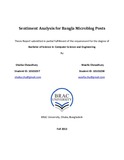| dc.contributor.author | Shaika, Chowdhury | |
| dc.contributor.author | Chowdhury, Wasifa | |
| dc.date.accessioned | 2014-01-29T06:58:08Z | |
| dc.date.available | 2014-01-29T06:58:08Z | |
| dc.date.issued | 2014-01 | |
| dc.identifier.other | ID 10101037 | |
| dc.identifier.other | ID 10101038 | |
| dc.identifier.uri | http://hdl.handle.net/10361/2902 | |
| dc.description | This thesis report is submitted in partial fulfillment of the requirements for the degree of Bachelor of Science in Computer Science and Engineering, 2014. | en_US |
| dc.description | Cataloged from PDF version of thesis report. | |
| dc.description | Includes bibliographical references (page 47). | |
| dc.description.abstract | Sentiment analysis has received great attention recently due to the huge amount of user-generated information on the microblogging sites, such as Twitter [1], which are utilized for many applications like product review mining and making future predictions of events such as predicting election results. Much of the research work on sentiment analysis has been applied to the English language, but construction of resources and tools for sentiment analysis in languages other than English is a growing need since the microblog posts are not just posted in English, but in other languages as well. Work on Bangla (or Bengali language) is necessary as it is one of the most spoken languages, ranked seventh in the world [13]. In this paper, we aim to automatically extract the sentiments or opinions conveyed by users from Bangla microblog posts and then identify the overall polarity of texts as either negative or positive. We use a semi-supervised bootstrapping approach for the development of the training corpus which avoids the need for labor intensive manual annotation. For classification, we use Support Vector Machines (SVM) and Maximum Entropy (MaxEnt) and do a comparative analysis on the performance of these two machine learning algorithms by experimenting with a combination of various sets of features. We also construct a Twitter-specific Bangla sentiment lexicon, which is utilized for the rule-based classifier and as a binary feature in the classifiers used. For our work, we choose Twitter as the microblogging site as it is one of the most popular microblogging platforms in the world. | en_US |
| dc.description.statementofresponsibility | Chowdhury, Shaika | |
| dc.description.statementofresponsibility | Chowdhury, Wasifa | |
| dc.format.extent | 47 pages | |
| dc.language.iso | en | en_US |
| dc.publisher | BRAC University | en_US |
| dc.rights | BRAC University thesis are protected by copyright. They may be viewed from this source for any purpose, but reproduction or distribution in any format is prohibited without written permission. | |
| dc.subject | Computer science and engineering | |
| dc.title | Sentiment analysis for Bangla microblog posts | en_US |
| dc.type | Thesis | en_US |
| dc.contributor.department | Department of Computer Science and Engineering, BRAC University | |
| dc.description.degree | B. Computer Science and Engineering | |

